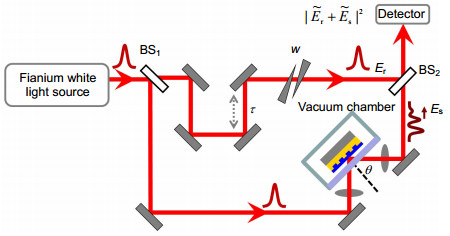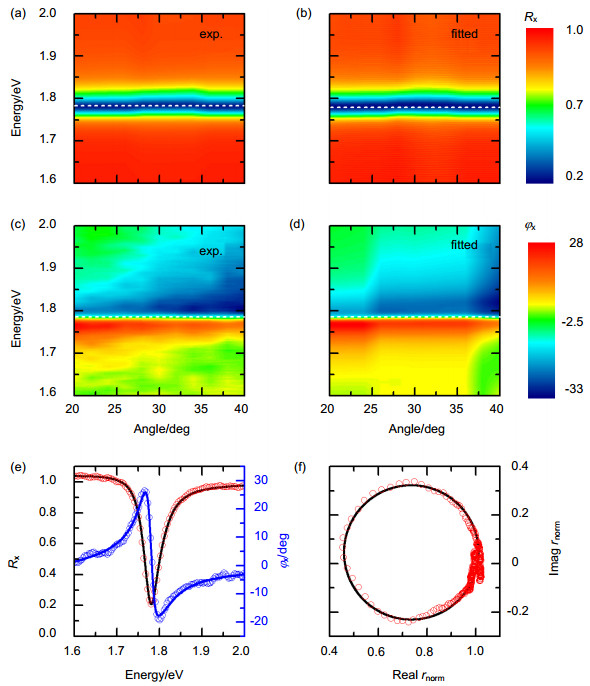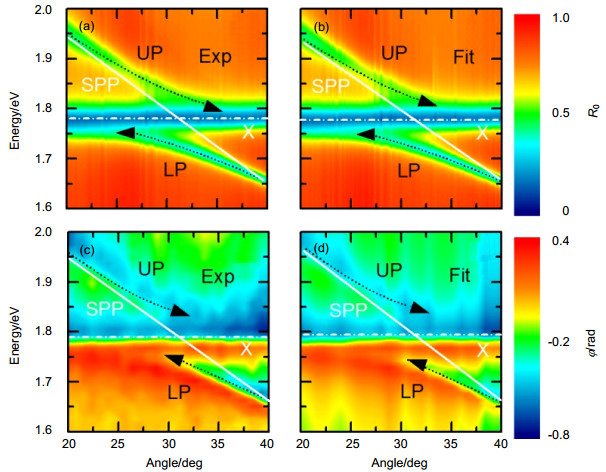Field‐level characterization of strong coupling between excitons and surface plasmon polaritons in J‐aggregate/metal hybrid nanostructures
-
Abstract:
White-light broadband chirp-compensated spectral interferometry is applied to fully probe the optical response of strongly coupled excitons (Xs) and surface plasmon polaritons (SPPs) in J-aggregate/metal hybrid nanostructures at field level. Under impulsive excitation, amplitude and spectral phase of the sample reflectivity are measured with high precision and the time structure of the electric field emitted by the hybrid modes of the nanostructures is accurately reconstructed. Quantitative description of strong X-SPP coupling is precisely obtained by fitting both measured spectra and phases simultaneously to a Fano lineshape model.

-

Abstract: Metallic nanostructures have highly interesting optical properties. When illuminating light on them, surface plasmon polaritons (SPP) can be induced due to the coupling of the electromagnetic fields to collective charge density oscillations near the metal surface. SPPs have recently been used in a variety of new applications due to their abilities to guide light on the scale of nanometer. However, most of these emerging applications are limited by the ultrashort lifetime of SPP and the corresponding short propagation length caused by the strong ohmic loss of metal and radiative damping within the nanostructures. Moreover, SPP is generally a photon-like optical excitation showing intrinsically weak nonlinearities, which hinders active nanoplasmonic device fabrication, such as all-optical switching or information processing.
A promising way to compensate losses and provide missing nonlinearity of SPPs is to couple SPPs to nonlinear optical resonances, such as excitons (Xs) in molecular or semiconducting nanostructures. Consequently, hybrid nanostructures containing J-aggregate molecules and metallic nanostructures have attracted considerable interest. Strong coupling between Xs and SPPs enables an efficient transfer of the strong optical nonlinearities of the excitonic emitters to the passive plasmonic nanostructures on the ultrashort time scale of femtosecond.
Here, we demonstrate a field-level characterization of the optical response of J-aggregate/metal hybrid nanostructures by white-light broadband chirp-compensated spectral interferometry. We show that both the amplitude and spectral phase of the strongly coupled X-SPP system can be measured with high precision by compensating the chirp in both arms of the interferometer. A quantitative description of both the excitonic resonance and the hybrid X-SPP polariton response is obtained by fitting the measured amplitudes and spectral phases simultaneously to a Fano lineshape model. We find that the resonance of the majority of J-aggregated molecules which are not coupled to SPPs is homogeneously broadened. We also demonstrate accurate reconstruction of the time structure of the electric field emitted by the hybrid nanostructures, corresponding to polarization oscillations with short damping time shorter than 100 fs.
-

-
Figure 3. Angle-resolved reflectivity spectra Rx(ω, θ). (a, b) and spectral phase φx(ω, θ). (c, d) of J-aggregate dye coated on planar gold film obtained from SI measurement (a, c) and the fitting (b, d) to Lorentzian oscillator model. The dashed lines mark the dye absorption at around 1.8 eV in (a, b) and the corresponding phase jump in (c, d). (e) Observed (red circles) and fitted (solid black) reflectivity spectra Rx(w), and the corresponding observed (blue circles) and fitted (solid blue) spectral phase φx(ω), measured at the incidence angle of 21°. (f) The corresponding observed normalized reflection coefficient plotted in complex plane (red circles). The solid black curve is the result fitted to a circular function.
-
[1] Guebrou S A, Symonds C, Homeyer E, et al. Coherent Emission from a Disordered Organic Semiconductor Induced by Strong Coupling with Surface Plasmons[J]. Physical Review Letters, 2012, 108(6): 066401. doi: 10.1103/PhysRevLett.108.066401
[2] Bozhevolnyi S I, Volkov V S, Devaux E, et al. Channel plasmon subwavelength waveguide components including interferometers and ring resonators[J]. Nature, 2006, 440(7083): 508–511. doi: 10.1038/nature04594
[3] Lal S, Link S, Halas N J. Nano-optics from sensing to waveguiding[J]. Nature Photonics, 2007, 1(11): 641–648. doi: 10.1038/nphoton.2007.223
[4] Maier S A, Kik P G, Atwater H A, et al. Local detection of electromagnetic energy transport below the diffraction limit in metal nanoparticle plasmon waveguides[J]. Nature Materials, 2003, 2(4): 229–232. doi: 10.1038/nmat852
[5] Stockman M I. Nanoplasmonics: past, present, and glimpse into future[J]. Optics Express, 2011, 19(22): 22029–22106. doi: 10.1364/OE.19.022029
[6] Abb M, Albella P, Aizpurua J, et al. All-optical control of a single plasmonic nanoantenna-ITO hybrid[J]. Nano Letters, 2011, 11(6): 2457–2463. doi: 10.1021/nl200901w
[7] Dintinger J, Robel I, Kamat P V, et al. Terahertz all-optical molecule-plasmon modulation[J]. Advanced Materials, 2006, 18(13): 1645–1648. doi: 10.1002/(ISSN)1521-4095
[8] MacDonald K F, Sámson Z L, Stockman M I, et al. Ultrafast active plasmonics[J]. Nature Photonics, 2009, 3(1): 55–58. doi: 10.1038/nphoton.2008.249
[9] Schwartz T, Hutchison J A, Genet C, et al. Reversible switching of ultrastrong light-molecule coupling[J]. Physical Review Letters, 2011, 106(19): 196405. doi: 10.1103/PhysRevLett.106.196405
[10] Vasa P, Pomraenke R, Cirmi G, et al. Ultrafast manipulation of strong coupling in metal-molecular aggregate hybrid nanostructures[J]. Acs Nano, 2010, 4(12): 7559–7565. doi: 10.1021/nn101973p
[11] Argyropoulos C, Chen P Y, Monticone F, et al. Nonlinear Plasmonic cloaks to realize giant all-optical scattering switching[J]. Physical Review Letters, 2012, 108(26): 263905. doi: 10.1103/PhysRevLett.108.263905
[12] Lu H, Liu X M, Wang L R, et al. Ultrafast all-optical switching in nanoplasmonic waveguide with Kerr nonlinear resonator[J]. Optics Express, 2011, 19(4): 2910–2915. doi: 10.1364/OE.19.002910
[13] Pacifici D, Lezec H J, Atwater H A. All-optical modulation by plasmonic excitation of CdSe quantum dots[J]. Nature Photonics, 2007, 1(7): 402–406. doi: 10.1038/nphoton.2007.95
[14] Pala R A, Shimizu K T, Melosh N A, et al. A nonvolatile plasmonic switch employing photochromic molecules[J]. Nano Letters, 2008, 8(5): 1506–1510. doi: 10.1021/nl0808839
[15] Valev V K, Baumberg J J, Sibilia C, et al. Chirality and chiroptical effects in plasmonic nanostructures: fundamentals, recent progress, and outlook[J]. Advanced Materials, 2013, 25(18): 2517–2534. doi: 10.1002/adma.201205178
[16] Chang D E, S rensen A S, Demler E A, et al. A single-photon transistor using nanoscale surface plasmons[J]. Nature Physics, 2007, 3(11): 807–812. doi: 10.1038/nphys708
[17] Hwang J, Pototschnig M, Lettow R, et al. A single-molecule optical transistor[J].Nature, 2009, 460(7251): 76–80. doi: 10.1038/nature08134
[18] Bellessa J, Bonnand C, Plenet J C, et al. Strong coupling between surface plasmons and excitons in an organic semiconductor[J]. Physical Review Letters, 2004, 93(3): 036404. doi: 10.1103/PhysRevLett.93.036404
[19] Symonds C, Bonnand C, Plenet J C, et al. Particularities of sur face plasmon-exciton strong coupling with large Rabi splitting[J]. New Journal of Physics, 2008, 10(6): 065017. doi: 10.1088/1367-2630/10/6/065017
[20] Hakala T K, Toppari J J, Kuzyk A, et al. Vacuum rabi splitting and strong-coupling dynamics for surface-plasmon polaritons and rhodamine 6G molecules[J]. Physical Review Letters, 2009, 103(5): 053602. doi: 10.1103/PhysRevLett.103.053602
[21] Fofang N T, Grady N K, Fan Z Y, et al. Plexciton Dynamics: Exciton-plasmon coupling in a J-aggregate-Au nanoshell complex provides a mechanism for nonllinearity[J]. Nano Letters, 2011, 11(4): 1556–1560. doi: 10.1021/nl104352j
[22] Zengin G, Johansson G, Johansson P, et al. Approaching the strong coupling limit in single plasmonic nanorods interacting with J-aggregates[J]. Scientific Reports, 2013, 3: 3074. doi: 10.1038/srep03074
[23] Schlather A E, Large N, Urban A S, et al. Near-field mediated plexcitonic coupling and giant rabi splitting in individual metallic dimers[J]. Nano Letters, 2013, 13(7): 3281–3286. doi: 10.1021/nl4014887
[24] Balci S, Kocabas C. Ultra hybrid plasmonics: strong coupling of plexcitons with plasmon polaritons[J]. Optics Letters, 2015, 40(14): 3424–3427. doi: 10.1364/OL.40.003424
[25] Vasa P, Wang W, Pomraenke R, et al. Real-time observation of ultrafast Rabi oscillations between excitons and plasmons in metal nanostructures with J-aggregates[J]. Nature Photonics, 2013, 7(2): 128–132. doi: 10.1038/nphoton.2012.340
[26] Wang W, Vasa P, Pomraenke R, et al. Interplay between strong coupling and radiative damping of excitons and surface plasmon polaritons in hybrid nanostructures[J].ACS Nano, 2014, 8(1): 1056–1064. doi: 10.1021/nn405981k
[27] Vasa P, Wang W, Pomraenke R, et al. Optical stark effects in J-aggregate-metal hybrid nanostructures exhibiting a strong exciton-surface-plasmon-polariton interaction[J]. Physical Review Letters, 2015, 114(3): 036802. doi: 10.1103/PhysRevLett.114.036802
[28] Reynaud F, Salin F, Barthelemy A. Measurement of phase shifts introduced by nonlinear optical phenomena on subpicosecond pulses[J]. Optics Letters, 1989, 14(5): 275–277. doi: 10.1364/OL.14.000275
[29] Lepetit L, Chériaux G, Joffre M. Linear techniques of phase measurement by femtosecond spectral interferometry for applications in spectroscopy[J]. Journal of the Optical Society of America B, 1995, 12(12): 2467–2474. doi: 10.1364/JOSAB.12.002467
[30] Ropers C, Park D J, Stibenz G, et al. Femtosecond light transmission and subradiant damping in plasmonic crystals[J]. Physical Review Letters, 2005, 94(11): 113901. doi: 10.1103/PhysRevLett.94.113901
[31] Rewitz C, Keitzl T, Tuchscherer P, et al. Ultrafast plasmon propagation in nanowires characterized by far-field spectral interferometry[J]. Nano Letters, 2012, 12(1): 45–49. doi: 10.1021/nl202864n
[32] Rajendran S K, Wang W, Brida D, et al. Direct evidence of Rabi oscillations and antiresonance in a strongly coupled organic microcavity[J]. Physical Review B, 2015, 91(20): 201305. doi: 10.1103/PhysRevB.91.201305
[33] Ceccarelli S, Wenus J, Skolnick M S, et al. Temperature dependent polariton emission from strongly coupled organic semiconductor microcavities[J]. Superlattices and Microstructures, 2007, 41(5–6): 289–292. doi: 10.1016/j.spmi.2007.03.003
[34] Jurna M, Garbacik E T, Korterik J P, et al. Visualizing resonances in the complex plane with vibrational phase contrast coherent anti-stokes raman scattering[J]. Analytical Chemistry, 2010, 82(18): 7656–7659. doi: 10.1021/ac101453s
-


 E-mail Alert
E-mail Alert RSS
RSS

 下载:
下载:







